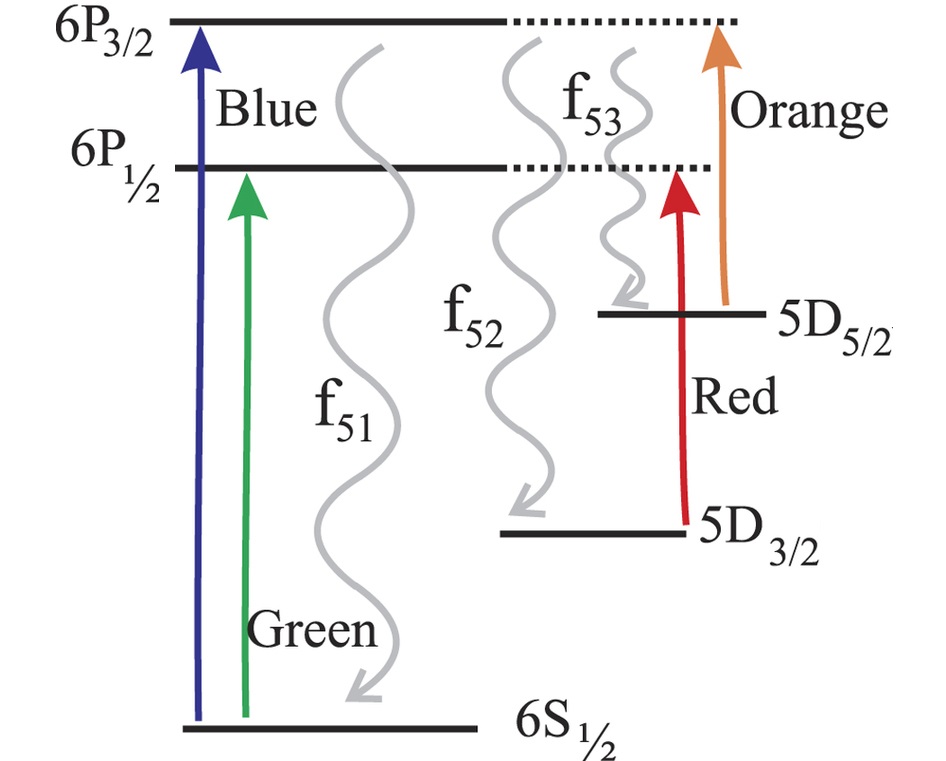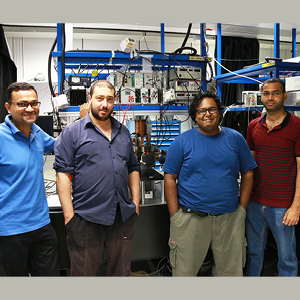Highlights
Technique eliminates errors in atomic transition measurements

One route to searching for new physics is precision measurement of the properties of atoms. CQT's Manas Mukherjee and his colleagues have debuted a new protocol to look in detail at how atoms moves between energy states, applying the technique to Barium ions (for the levels illustrated above). Image adapted from Science Reports 6, 29772 (2016).
Researchers at CQT have found a novel way to measure the probabilities of an excited atom's decay into different channels. The technique has no significant systematic uncertainties, according to the team's careful analysis, enabling measurements of transition probabilities in Barium ions (Ba+) with record precision. What's more, the technique should work for other atoms too.
Principal Investigator Manas Mukherjee led the work, which is published 19 July in Science Reports.
His group are particularly interested in Barium because it's predicted to show atomic parity violation, an asymmetry in its properties that may show evidence of physics beyond the Standard Model. Barium is also an astronomical puzzle, showing up in larger than expected quantities in some kinds of stars.
In previous experiments, Manas' team made precision measurements of how Ba+ decays from an excited state called the 6P1/2 level via either of two branches. Their new paper extends this work by looking at decay patterns from a state one up the excited ladder, 6P3/2 (see picture), from which there are three possible routes down.
The innovation is finding a way to apply the technique from their previous work – in which precision comes from counting photons emitted when the ion decays from a higher to lower energy level – to this higher set of energy levels. It is not straightforward because the 6P3/2 state is sensitive to magnetic fields, in a way the 6P1/2 state was not. Because the field around the ions tends to vary over time, this causes shifts in the decay patterns between different experimental runs – a source of systematic error.
The three possible decay paths from 6P3/2 are analysed pairwise, with one path blocked in each measurement. The results of two pairwise measurements are combined to estimate the probabilities, known as branching fractions, for each of the three decay routes (the three probabilities must add up to one). The trick to eliminating the magnetic field fluctuation error is to measure the ratios via the 6P1/2 state which is insensitive to the field fluctuation. The process is repeated many times to improve the accuracy of this estimate.
To perform these experiments, a few ions are trapped in a line inside a vacuum chamber. Lasers of the right colours are aimed precisely at the ions to make them jump up energy levels, and photon detectors measure light emitted when the ions jump down. Each measurement cycle takes 320 microseconds and requires four different frequency-stabilised lasers pulsing in sync. The cycles were repeated 3 million times to count as one experiment. And to check for systematic uncertainties, that experiment was performed 18 times.
That's not all the work that went into the result. Each time before taking data, the researchers would need to spend two or three hours getting the setup ready. There had also been months before this spent building the experiment."Keeping the whole system stable for such a long time is not an easy task. We have developed almost all the stuff by ourselves, meaning home-built, starting from electronics to the external cavity-diode laser," says Tarun. Indeed, the team have published a paper about development of one of the critical lasers in the Journal of the Optical Society of America B.
With the new results building on their earlier work, Manas' team say they now have almost all the data they need to check theoretical predictions for parity violation in Barium ion. Their measurements already constrain predicted transition probabilities (a feat achieved for few atomic species). The next step will be to probe the violation of parity in the barium ion energy levels.
Learn more
Related Stories
 | Exacting measurements on atoms do better than theory April 22 2015 |






